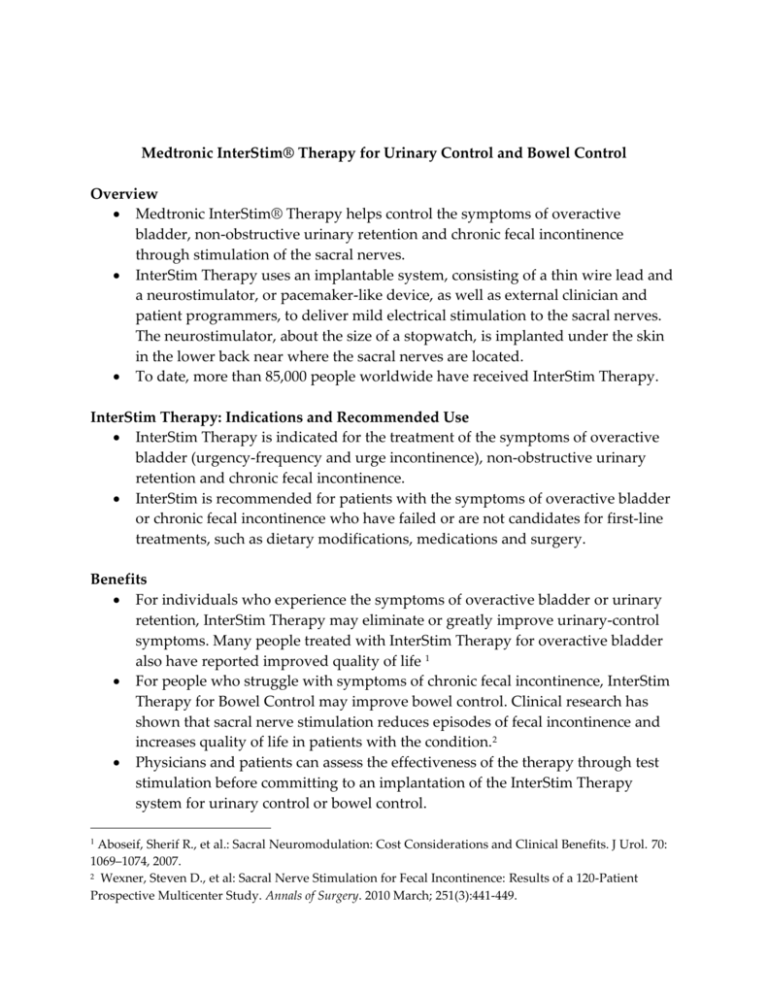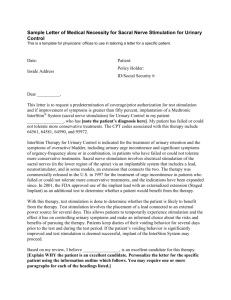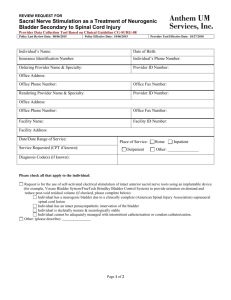Medtronic InterStim® Therapy for Urinary Control
advertisement

Medtronic InterStim® Therapy for Urinary Control and Bowel Control Overview Medtronic InterStim® Therapy helps control the symptoms of overactive bladder, non-obstructive urinary retention and chronic fecal incontinence through stimulation of the sacral nerves. InterStim Therapy uses an implantable system, consisting of a thin wire lead and a neurostimulator, or pacemaker-like device, as well as external clinician and patient programmers, to deliver mild electrical stimulation to the sacral nerves. The neurostimulator, about the size of a stopwatch, is implanted under the skin in the lower back near where the sacral nerves are located. To date, more than 85,000 people worldwide have received InterStim Therapy. InterStim Therapy: Indications and Recommended Use InterStim Therapy is indicated for the treatment of the symptoms of overactive bladder (urgency-frequency and urge incontinence), non-obstructive urinary retention and chronic fecal incontinence. InterStim is recommended for patients with the symptoms of overactive bladder or chronic fecal incontinence who have failed or are not candidates for first-line treatments, such as dietary modifications, medications and surgery. Benefits For individuals who experience the symptoms of overactive bladder or urinary retention, InterStim Therapy may eliminate or greatly improve urinary-control symptoms. Many people treated with InterStim Therapy for overactive bladder also have reported improved quality of life 1 For people who struggle with symptoms of chronic fecal incontinence, InterStim Therapy for Bowel Control may improve bowel control. Clinical research has shown that sacral nerve stimulation reduces episodes of fecal incontinence and increases quality of life in patients with the condition.2 Physicians and patients can assess the effectiveness of the therapy through test stimulation before committing to an implantation of the InterStim Therapy system for urinary control or bowel control. 1 Aboseif, Sherif R., et al.: Sacral Neuromodulation: Cost Considerations and Clinical Benefits. J Urol. 70: 1069–1074, 2007. 2 Wexner, Steven D., et al: Sacral Nerve Stimulation for Fecal Incontinence: Results of a 120-Patient Prospective Multicenter Study. Annals of Surgery. 2010 March; 251(3):441-449. Even after implantation, the treatment is reversible and can be discontinued at any time by turning off or surgically removing the device. Patients Who May Consider InterStim Therapy Patients may consider InterStim Therapy under advisement from their physician when their bladder control or bowel control problems have affected their lifestyle to the point where they struggle with everyday activities such as traveling, going to the gym, or spending time with friends and family. InterStim Therapy does not treat every type of bladder control or bowel control problem. It is not intended for patients with conditions such as benign prostatic hyperplasia (BPH), cancer or urethral stricture, all of which may produce urinary symptoms due to an obstruction. For more information on InterStim Therapy, please visit www.medtronic.com/bowel How InterStim Works Treatment with InterStim Therapy involves three steps: test stimulation, a minimally invasive surgical implant, and ongoing post-implant follow-up appointments. Test Stimulation: The test stimulation process begins with a simple in-office or outpatient procedure to place a thin wire, or lead, that stimulates the sacral nerves using an external stimulator. The patient typically wears the external stimulator for several days to determine if a patient is likely to benefit from InterStim Therapy Surgical Implant: Following a successful trial, a different, long-term neurostimulator is implanted under the skin in the lower back area in a minimally invasive outpatient procedure. The physician then adjusts the stimulation settings to optimize the therapy for each patient. . Post-Implant: Following the implant procedure, the patient can control the neurostimulation intensity within physician-set parameters using an external patient programmer that works like a remote control to turn the stimulation up and down or on and off. Follow-up examinations usually occur every six to 12 months to monitor the therapy’s effectiveness. Safety Profile There are risks with InterStim Therapy. They include, but are not limited to, pain at the implant site, risks associated with the procedure itself and possible infection. In addition to the risk related to a medical procedure, complications from this therapy can include new pain, device problems, lead movement/migration, and adverse change in bowel function, among others. These complications were shown to be generally resolvable in a clinical study. Medical Coverage and Cost-Effectiveness InterStim Therapy for Urinary Control is covered by most private insurance companies, and Medicare has a national policy providing coverage for all approved urinary control indications. As with most new indications or technologies, InterStim Therapy for Bowel Control is in the process of gaining coverage with private insurance and local Medicare carriers. Medtronic anticipates that with time and further patient experience with the therapy coverage will continue to expand. In a U.K. clinical study assessing the cost-effectiveness of InterStim Therapy for Bowel Control, the £25 070 incremental cost-effectiveness ratio (ICER) of InterStim Therapy compared to non-surgical treatment based on direct medical and non-medical costs was within the £30 000 quality-adjusted life year (QALY) threshold recommended by the National Institute for Health and Clinical Excellence (NICE). 3 Dudding, T. C., Meng Lee, E., Faiz, O., Parés, D., Vaizey, C. J., McGuire, A. and Kamm, M. A. (2008), Economic evaluation of sacral nerve stimulation for faecal incontinence. British Journal of Surgery, 95: 1155–1163. 3 Important Safety Information Indications for Use: ® InterStim Therapy for Urinary Control is indicated for the treatment of urinary retention and the symptoms of overactive bladder, including urinary urge incontinence and significant symptoms of urgency-frequency alone or in combination, in patients who have failed or could not tolerate more conservative treatments. The following Warning applies only to InterStim Therapy for Urinary Control: Warning: This therapy is not intended for patients with mechanical obstruction such as benign prostatic hypertrophy, cancer, or urethral stricture. ® InterStim Therapy for Bowel Control is indicated for the treatment of chronic fecal incontinence in patients who have failed or are not candidates for more conservative treatments. Contraindications for Urinary Control and for Bowel Control: Diathermy. Patients who have not demonstrated an appropriate response to test stimulation or are unable to operate the neurostimulator. Precautions/Adverse Events: For Urinary Control: Safety and effectiveness have not been established for bilateral stimulation; pregnancy, unborn fetus, and delivery; pediatric use under the age of 16; or for patients with neurological disease origins such as multiple sclerosis. For Bowel Control: Safety and effectiveness have not been established for bilateral stimulation; pregnancy, unborn fetus, and delivery; pediatric use under the age of 18; or for patients with progressive, systemic neurological diseases. For Urinary Control and for Bowel Control: The system may be affected by or adversely affect cardiac devices, electrocautery, defibrillators, ultrasonic equipment, radiation therapy, MRI, theft detectors/screening devices. Adverse events include pain at the implant sites, new pain, lead migration, infection, technical or device problems, adverse change in bowel or voiding function, and undesirable stimulation or sensations, including jolting or shock sensations. Product technical manual must be reviewed prior to use for detailed disclosure. USA Rx Only. Rev 0409






